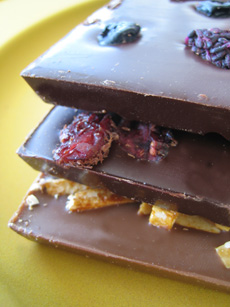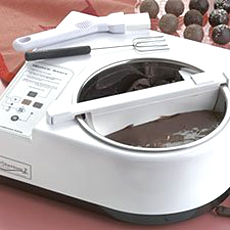 
Artisanal bars from Michael Mischer Chocolates of Oakland, California. Photo by Melody Lan | THE NIBBLE.
|
KAREN HOCHMAN’s first word was not cacahuatl...but as her mother will attest, it was pretty close.
|
|
May 2006
Revised January 2009
|
 |
From Pod to Palate: The Birth Of The Bar
Page 8: Making The Chocolate ~ Tempering The Chocolate
This is Page 8 of a 10-page article on chocolate production. Click on the black links below to visit other pages.
Making The Chocolate
13. Tempering
There’s one more critical step left before chocolate for consumption can be made: the chocolate must be tempered. Chocolate is not shiny and smooth by nature. Without tempering, large crystals would form; the chocolate would have a gritty texture and a dull appearance and/or the cocoa butter would separate out (as cream separates from milk) creating a greyish-white bloom on the surface. After the conching and before being molded into bars or made into filled chocolates, the chocolate paste must be tempered, a delicate process that involves slowly heating and cooling the chocolate repeatedly to temperatures between 105°F and 85°F. This stabilizes the product and achieves the smooth, shiny texture, pleasant mouthfeel and a sharp “snap” when a piece is broken off. This is a complicated procedure because the various fats in cocoa butter have different melting and congealing points. Chocolate that isn’t properly tempered will turn grey and crumbly as it hardens.
Well-tempered chocolate melts better in the mouth and has a long shelf life. If not tempered properly the finished chocolate will be dull and streaky with a tendency to bloom. In an industrial situation, this is done in large tempering machines. In an artisan’s shop, it is done by hand: the classic tempering method is to melt the chocolate until it is lump-free. Then 1/3 of the chocolate is poured onto a marble slab, spread and worked back and forth with a metal spatula until it becomes thick and reaches a temperature of about 80°F. This chocolate is then added back to the remaining 2/3 of the melted chocolate and stirred. |

This chocolate tempering machine is a
good size for small artisans or home
use. |
The process is repeated until the entire mixture reaches 88° to 92° for semi-sweet chocolate, 84° to 87° for milk or white chocolate. Care must be taken not to over-temper chocolate, which returns it to its original state—grainy and susceptible to bloom.
The resulting chocolate is called couverture and forms the basis of most finished chocolate products. It can be molded into chocolate bars or made into truffles or used to enrobe a box of assorted chocolates. Now, the couverture is ready to be shaped into the end product for you, the consumer.
Continue To Page 9: Molding The Chocolate
Go To The Article Index Above

|





